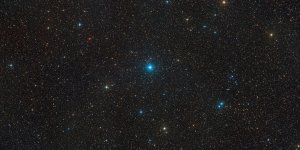Space

Researchers capture birth of two planets orbiting the star PDS 70. »

Observations made with the European Southern Observatory’s Very Large Telescope (ESO’s VLT) have revealed the telltale signs of a star system being born. »

A team of astronomers from the European Southern Observatory (ESO) and other institutes has discovered a black hole lying just 1000 light-years from Earth. »

A Venusian day, which is one full rotation of the planet, takes 243 Earth days, but researchers found out that its atmosphere rotates 60 times faster. »

Astronomers have found a unique star system with multiple planets orbiting it 88 light-years away. »

The U.S. Geological Survey has released a new authoritative map to help explain the 4.5-billion-year-old history of our nearest neighbor in space. »

Scientists, using reanalyzed data from NASA's Kepler space telescope, has discovered an Earth-size exoplanet orbiting in its star's habitable zone, the area around a star where a rocky planet could support liquid water. »

For the first time, scientists have directly measured wind speed on a brown dwarf, an object larger than Jupiter (the largest planet in our solar system) but not quite massive enough to become a star. »

New mapping of the giant planet's upper atmosphere reveals likely reason why it's so hot. »

Scientists are finding that Earth's mantle may have generated the planet's early magnetic field. »

Researchers using ESO’s Very Large Telescope have observed an extreme planet where they suspect it rains iron. The ultra-hot giant exoplanet has a day side where temperatures climb above 2400 degrees Celsius, high enough to vaporise metals. »

NASA's Curiosity rover has captured its highest-resolution panorama yet of the Martian surface. »

Using ESO’s Very Large Telescope (VLT), astronomers have captured the unprecedented dimming of Betelgeuse, a red supergiant star in the constellation of Orion. The stunning new images of the star’s surface show not only the fading red supergiant but also how its apparent shape is changing. »

Just released first images from the National Science Foundation’s Daniel K. Inouye Solar Telescope reveal unprecedented detail of the sun’s surface and preview the world-class products to come from this preeminent 4-meter solar telescope. »

Astronomers have traced the journey of phosphorus from star-forming regions to comets using the combined powers of ALMA and the European Space Agency’s probe Rosetta. »

NASA's Transiting Exoplanet Survey Satellite (TESS) has discovered its first Earth-size planet in its star's habitable zone, the range of distances where conditions may be just right to allow the presence of liquid water on the surface. »

This majestic spiral galaxy might earn the nickname the "Godzilla galaxy" because it may be the largest known in the local universe. The galaxy, UGC 2885, is 2.5 times wider than our Milky Way and contains 10 times as many stars. »

Picture helps answer important questions about how galaxies acquire magnetic fields. »

"Super-Puffs" may sound like a new breakfast cereal. But it's actually the nickname for a unique and rare class of young exoplanets that have the density of cotton candy. Nothing like them exists in our solar system. »

This image from NASA's Spitzer Space Telescope shows the Perseus Molecular Cloud, a massive collection of gas and dust that stretches over 500 light-years across. »

Astronomers using ESO’s Very Large Telescope have observed reservoirs of cool gas around some of the earliest galaxies in the Universe. These gas halos are the perfect food for supermassive black holes at the centre of these galaxies, which are now seen as they were over 12.5 billion years ago. »

Radio telescopes detect light of massive galaxy seen 970 million years after the Big Bang. »

The most extensive survey of atmospheric chemical compositions of exoplanets to date has revealed trends that challenge current theories of planet formation and has implications for the search for water in the solar system and beyond. »

NASA has big plans for returning astronauts to the Moon in 2024, a stepping stone on the path to sending humans to Mars. »

Shortly after NASA's OSIRIS-REx spacecraft arrived at asteroid Bennu, an unexpected discovery by the mission's science team revealed that the asteroid could be active, or consistently discharging particles into space. »

ESO observations indicate the Neptune-like exoplanet is evaporating. »

Astronomers spotted a stellar black hole 15,000 light-years away that is 70 times the mass of the sun. »

Thousands of planets could be orbiting around black holes just like we orbit the Sun, according to scientists. »

Dust storms are common on Mars. But every decade or so, something unpredictable happens: A series of runaway storms breaks out, covering the entire planet in a dusty haze. »

In this perpetual choreography, Naiad swirls around the ice giant every seven hours, while Thalassa, on the outside track, takes seven and a half hours. An observer sitting on Thalassa would see Naiad in an orbit that varies wildly in a zigzag pattern, passing by twice from above and then twice from below. »

Reexamination of 2016 data finds matching explosion observed in 2017 by LIGO. »

An exoplanet may seem like the perfect spot to set up housekeeping, but before you go there, take a closer look at its star. »

Astronomers using ESO’s SPHERE instrument at the Very Large Telescope (VLT) have revealed that the asteroid Hygiea could be classified as a dwarf planet. »

In the deadly 2018 earthquake in the Indonesian city of Palu, intense shaking changed solid ground into a landslide of flowing mud, multiplying the death toll and economic impact. A new paper shows that this disastrous effect was triggered by a previously unknown risk factor: flooding rice fields for farming. »
